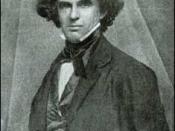Puritanism in Nathaniel Hawthorne's "The Minister's Black Veil"
Nathaniel Hawthorne's "The Minister's Black Veil" is a story about sin and the dark side of the Puritan religion. Hawthorne was a descendent of Puritan immigrants and grew up in Salem, Massachusetts where Puritanism was quite prevalent. While his story emphasizes Puritan beliefs, it criticizes those with which he disagrees. Through the use of symbols, Hawthorne uses his writing as a channel to prove the hypocrisy and extremities of the Puritan people and their religion.
The Puritans emphasize a strong sense of community. They live in small towns, know each other well, and most importantly, pray and go to church together. But when sin is involved, everything changes. Reverend Hooper is ostracized when he wears the black veil. His status as a leader in the church diminishes and his community ties gradually fall apart. The community is far more concerned with the negative, outward appearance Reverend Hooper is casting over them than they are about his internal struggle with guilt.
Hawthorne attempts to show the reader that the Puritan reaction to sin is far too extreme and more importantly, hypocritical. "The Minister's Black Veil" is a story emphasizing the old Biblical saying "let those who have not sinned, cast the first stone." The community members are so obsessed with Reverend Hooper's sin that they don't understand the message he is trying to portray. The message is finally heard when Hooper was upon his death bed and said, "I look around me, and lo! on every visage a black veil" (Hawthorne 634). After years of wearing the black veil, he actually had to tell the community members to look deeper into the meaning and to start worrying about themselves before worrying about others.
The Puritans believe in...


